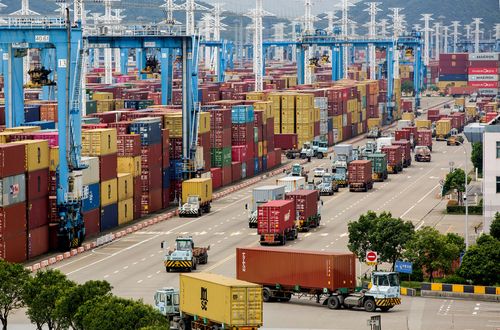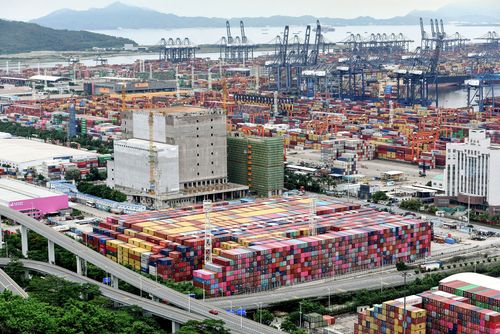Worsening shipping crisis set to impact Christmas shopping
The vast network of ports, container vessels and trucking companies that moves goods around the world is badly tangled, and the cost of shipping is skyrocketing.
That’s troubling news for retailers and holiday shoppers.
More than 18 months into the pandemic, the disruption to global supply chains is getting worse, spurring shortages of consumer products and making it more expensive for companies to ship goods where they’re needed.

Unresolved snags, and the emergence of new problems including the Delta variant, mean shoppers are likely to face higher prices and fewer choices this holiday season.
Consumer goods companies, such as Adidas and Hasbro, are already warning of disruptions as they prepare for the crucial year-end period.
“The pressures on global supply chains have not eased, and we do not expect them to any time soon,” said Bob Biesterfeld, the CEO of C.H. Robinson, one of the world’s largest logistics firms.
The latest obstacle is in China, where a terminal at the Ningbo-Zhoushan Port south of Shanghai has been shut since August 11 after a dock worker tested positive for COVID-19.
Major international shipping lines, including Maersk, Hapag-Lloyd and CMA CGM have adjusted schedules to avoid the port and are warning customers of delays.
The partial closure of the world’s third busiest container port is disrupting other ports in China, stretching supply chains that were already suffering from recent problems at Yantian port, ongoing container shortages, coronavirus-related factory shutdowns in Vietnam and the lingering effects of the Suez Canal blockage in March.
Shipping companies expect the global crunch to continue.
That’s massively increasing the cost of moving cargo and could add to the upward pressure on consumer prices.
“We currently expect the market situation only to ease in the first quarter of 2022 at the earliest,” Hapag-Lloyd chief executive Rolf Habben Jansen said in a recent statement.
The cost of shipping goods from China to North America and Europe has continued to climb over the past few months, following a spike earlier in the year, according to data from London-based Drewry Shipping.
The company’s World Container Index shows that the composite cost of shipping a 40-foot container on eight major East-West routes hit $13,327 in the week to August 19, up 360 per cent from a year ago.
“The current historically high freight rates are caused by the fact that there is unmet demand,” Soren Skou, CEO of container shipping giant Maersk, said on an earnings call this month.
“There’s simply not enough capacity,” he added.

Port congestion
The terminal shutdown in Ningbo will add to bottlenecks arising from the closure in June of Yantian, a port about 80 kilometres north of Hong Kong, after coronavirus infections were detected among dock workers.
While a partial reopening of Yantian took only a few days, a return to normal services took nearly a month to achieve, according to S&P Global Market Intelligence Panjiva, as the congestion spilled over to other ports.
That spells trouble for retailers and consumer goods companies trying to restock inventories heading into the crucial year-end holiday shopping season.
Drewry Shipping said congestion at nearby ports Shanghai and Hong Kong is “spiking” and spreading elsewhere in Asia.
It’s not just ports that are under pressure.
Air terminals are receiving increasingly large amounts of freight as companies turn to alternative methods to transport their goods.
Efforts to contain COVID-19 outbreaks have recently disrupted traffic at Shanghai Pudong and Nanjing airports in China.

Retailers brace for impact
“Name almost anything and it seems like there’s a shortage of it somewhere,” Biesterfeld added.
“Retailers are struggling to replenish inventory as fast as they’re selling, let alone prepare for holiday demand.”
Supply chains were discussed on nearly two thirds of some 7000 company earnings calls globally in July, up from 59 per cent in the same month last year, according to an analysis by S&P Global Panjiva.
Consumer goods producers are taking drastic steps to meet demand — such as changing where products are made and moving them by plane instead of boat.
To ensure product availability during the holiday season, Hasbro, which makes Monopoly and My Little Pony, said it is increasing the number of ocean carriers it works with, utilising more ports to expedite deliveries and sourcing more products earlier from multiple countries.
For consumers, the supply chain crunch is likely to mean higher prices.
Hasbro, for example, is increasing prices to offset rising freight and commodities costs.
The company is projecting that its ocean freight expenses will be on average four times higher this year than last, according to chief financial officer Deborah Thomas.
Shoppers should also brace for longer than normal delivery times and may need to have several different gift ideas up their sleeves.








